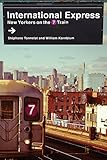International express : New Yorkers on the 7 train / Stéphane Tonnelat and William Kornblum.
Material type: TextPublication details: New York : Columbia University Press, (c)2017.Description: 1 online resourceContent type:
TextPublication details: New York : Columbia University Press, (c)2017.Description: 1 online resourceContent type: - text
- computer
- online resource
- 9780231543613
- F128 .I584 2017
- COPYRIGHT NOT covered - Click this link to request copyright permission: https://lib.ciu.edu/copyright-request-form
| Item type | Current library | Collection | Call number | URL | Status | Date due | Barcode | |
|---|---|---|---|---|---|---|---|---|
 Online Book (LOGIN USING YOUR MY CIU LOGIN AND PASSWORD)
Online Book (LOGIN USING YOUR MY CIU LOGIN AND PASSWORD)
|
G. Allen Fleece Library ONLINE | Non-fiction | F128.9.1 (Browse shelf(Opens below)) | Link to resource | Available | ocn964066043 |
Includes bibliographies and index.
Becoming New Yorkers on the 7 train -- Coping with diversity aboard the "International Express" -- Walking to the stations, code switching, and the I-we-you shift -- The 74th Street/Roosevelt Avenue Station: universalism, differentiation, and discrimination -- Trust in the subway: exploring the situational community in transit -- Gender relations on the subway -- Teenagers on the 7 train -- Subway city: the 7 train as an engine of urbanism -- Conclusion: a world of subway citizens.
Nicknamed the International Express, the New York City Transit Authority 7 subway line runs through a highly diverse series of ethnic and immigrant neighborhoods in Queens. People from Andean South America, Central America, China, India, Italy, Korea, Mexico, Pakistan, Poland, Romania, and Vietnam, as well as residents of a number of gentrifying blue-collar and industrial neighborhoods, fill the busy streets around the stations. The 7 train is a microcosm of a specifically urban, New York experience, in which individuals from a variety of cultures and social classes are forced to interact and get along with one another. For newcomers to the city, mastery of life in the subway space is a step toward assimilation into their new home.In International Express, the French ethnographer Stéphane Tonnelat and his collaborator William Kornblum, a native New Yorker, ride the 7 subway line to better understand the intricacies of this phenomenon. They also ask a group of students with immigrant backgrounds to keep diaries of their daily rides on the 7 train. What develops over time, they find, is a set of shared subway competences leading to a practical cosmopolitanism among riders, including immigrants and their children, that changes their personal values and attitudes toward others in small, subtle ways. This growing civility helps newcomers feel at home in an alien city and builds what the authors call a "situational community in transit." Yet riding the subway can be problematic, especially for women and teenagers. Tonnelat and Kornblum pay particular attention to gender and age relations on the 7 train. Their portrait of integrated mass transit, including a discussion of the relationship between urban density and diversity, is invaluable for social scientists and urban planners eager to enhance the cooperative experience of city living for immigrants and ease the process of cultural transition.
COPYRIGHT NOT covered - Click this link to request copyright permission:
There are no comments on this title.
